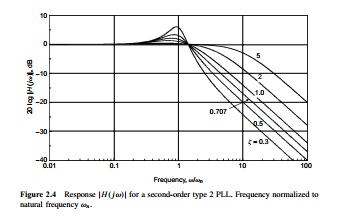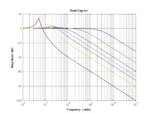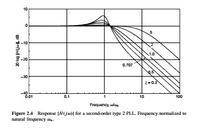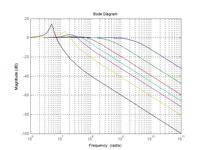netbug
Junior Member level 2

Dear all,
I am doing some Matlab code to simulate PLLs. I am using the book "PhaseLock Techniques" by Gardner. I wanted to replicate some of the graphs to check my understanding. However I can't.
For eg. in the book Gardner plots 20 log|H(jw)| vs w/wn. Maybe this is a silly question, but all that I have in my TF are "symbolic variables", there are no defined values for each variable. As far as I know there is no way to generate a symbolic TF and apply a step to it.If somenone has the book, please refer to page 15 of the 3rd. edition.So there should be some known values to plot these curvesl ike, for instance, bandwidth. But then, this curves represent a particular case and not a generic one.
The TF used in the book is:
\[ H(s)=\frac{K(s+K/ 4\zeta^2)}{s^2 + Ks + K^2/4 \zeta^2}= \frac{K(s + 1/ \tau2)}{s^2 + Ks + K/ \tau2}\]
where
\[K=K_dK_oK_1= \frac{K_d K_o \tau2}{\tau1}\]
and
\[ \omega_n=\sqrt{\frac{K}{\tau2} }\] and \[ \zeta=\frac{1}{2} \sqrt{K \tau2}\]
and here you have a scanned image from Gardner's book:

Now, how to plot mag(H(s)) vs w/wn and w/wK ? As \[ \tau2 \] and \[\tau1\] are time constants of the filter, we should know these values "a priori", correct ?
Thanks in advance.
Best regards,
Pedro
I am doing some Matlab code to simulate PLLs. I am using the book "PhaseLock Techniques" by Gardner. I wanted to replicate some of the graphs to check my understanding. However I can't.
For eg. in the book Gardner plots 20 log|H(jw)| vs w/wn. Maybe this is a silly question, but all that I have in my TF are "symbolic variables", there are no defined values for each variable. As far as I know there is no way to generate a symbolic TF and apply a step to it.If somenone has the book, please refer to page 15 of the 3rd. edition.So there should be some known values to plot these curvesl ike, for instance, bandwidth. But then, this curves represent a particular case and not a generic one.
The TF used in the book is:
\[ H(s)=\frac{K(s+K/ 4\zeta^2)}{s^2 + Ks + K^2/4 \zeta^2}= \frac{K(s + 1/ \tau2)}{s^2 + Ks + K/ \tau2}\]
where
\[K=K_dK_oK_1= \frac{K_d K_o \tau2}{\tau1}\]
and
\[ \omega_n=\sqrt{\frac{K}{\tau2} }\] and \[ \zeta=\frac{1}{2} \sqrt{K \tau2}\]
and here you have a scanned image from Gardner's book:

Now, how to plot mag(H(s)) vs w/wn and w/wK ? As \[ \tau2 \] and \[\tau1\] are time constants of the filter, we should know these values "a priori", correct ?
Thanks in advance.
Best regards,
Pedro




